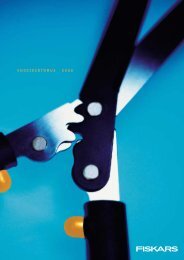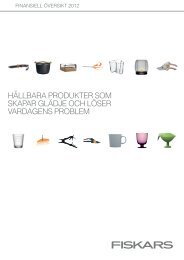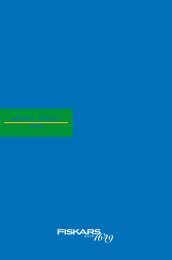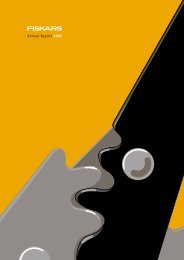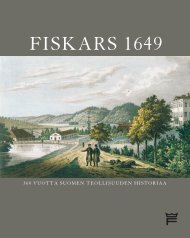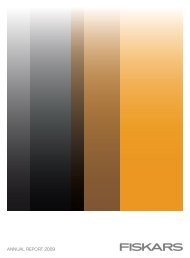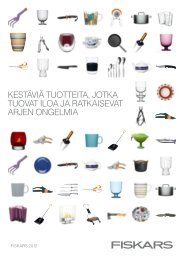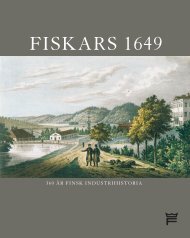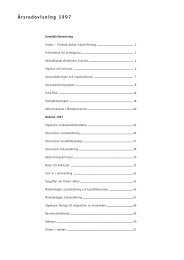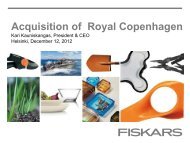FISKARS 1649 â 360 years of Finnish industrial history
FISKARS 1649 â 360 years of Finnish industrial history
FISKARS 1649 â 360 years of Finnish industrial history
You also want an ePaper? Increase the reach of your titles
YUMPU automatically turns print PDFs into web optimized ePapers that Google loves.
Fiskars <strong>1649</strong><br />
Fiskars <strong>1649</strong><br />
From 1846 onwards, the builders<br />
<strong>of</strong> the Saimaa Canal became one <strong>of</strong><br />
Fiskars’ major customers. At first,<br />
Fiskars supplied tools, and later on<br />
also parts <strong>of</strong> the canal locks and<br />
rolling bridges.<br />
who were working, could receive an education. In<br />
the 1840s, the weekday school had 45 pupils and the<br />
Sunday school 35.<br />
Julin was also a pioneer in agriculture and<br />
forestry. He turned Fiskars into a model farm,<br />
organizing agricultural shows at which the best<br />
livestock breeders won awards and new implements<br />
were introduced. It was only now that horses began<br />
to replace oxen as beasts <strong>of</strong> burden in Fiskars. In<br />
summer, the tenant farmers <strong>of</strong> the manor and the<br />
day labourers would work from four in the morning<br />
to eight in the evening, with two one-hour breaks<br />
for meals. Julin introduced crop rotation in the<br />
1830s. Livestock breeding was not given up until<br />
1970, at which point Fiskars still had 104 head <strong>of</strong><br />
cattle, descended from the Ayrshire herd <strong>of</strong> Julin’s<br />
time.<br />
Julin travelled a lot in Sweden and Britain,<br />
gathering information on fine iron forging among<br />
other things. Finland’s first fine forging workshop<br />
was built at Fiskars in the early 1830s. It employed<br />
17 people and comprised a coarse and fine forging<br />
mill, a filing workshop and a coppersmith’s<br />
workshop. Edward Hill, an Englishman, was the<br />
workshop supervisor, and he brought skilled smiths<br />
with him from England. Knives, forks and scissors<br />
were then produced at the workshop.<br />
The work <strong>of</strong> the fine forgers was an art and the<br />
training usually took eight <strong>years</strong>. The fine forgers<br />
guarded their pr<strong>of</strong>essional secrets carefully. They<br />
even had their own lockers in the workshop,<br />
where they locked up their unfinished work. In<br />
the 1880s, working hours began at 5.30 a.m. There<br />
was a 30-minute breakfast break at 8, and a 1-hour<br />
lunch break at 1 p.m., after which work continued<br />
uninterruptedly till 7.15 p.m., with only a brief<br />
c<strong>of</strong>fee break in the afternoon. On Saturdays, they<br />
stopped work at 5.30 p.m. In the <strong>of</strong>fice, work started<br />
at 7 a.m. and ended at 7 p.m.<br />
Finland’s first machine workshop was established<br />
at Fiskars in 1837, with mechanic David Cowie<br />
and designer Anders Ericsson from Sweden as<br />
shareholders. Orders came pouring in. In 1838, the<br />
workshop produced the first <strong>Finnish</strong> steamship<br />
engine, for the SS Helsingfors. In winter 1851,<br />
the SS Majava was built on the ice in Pohjankuru<br />
harbour. The finished components were transported<br />
from Fiskars by horse and sleigh to the building<br />
site where the ship was assembled. When the ice<br />
melted in spring, the vessel was launched by itself.<br />
The machine workshop also produced the iron<br />
gate and bridge structures for the Saimaa Canal,<br />
blowers and warm air generators. From the 1850s<br />
on, agricultural equipment such as ploughs, chaff<br />
rakes and sowing machinery was made.<br />
In 1836, a foundry with two cupola furnaces was<br />
completed on the upper Fiskars rapids. Its products<br />
were primarily used by the ironworks, but some<br />
pots, frying pans, stoves and other household utensils<br />
were made for sale, too. The Fiskars foundry also<br />
made a delivery that was strikingly unusual in<br />
Finland at that time: 90 cast-iron columns and a<br />
28<br />
29



